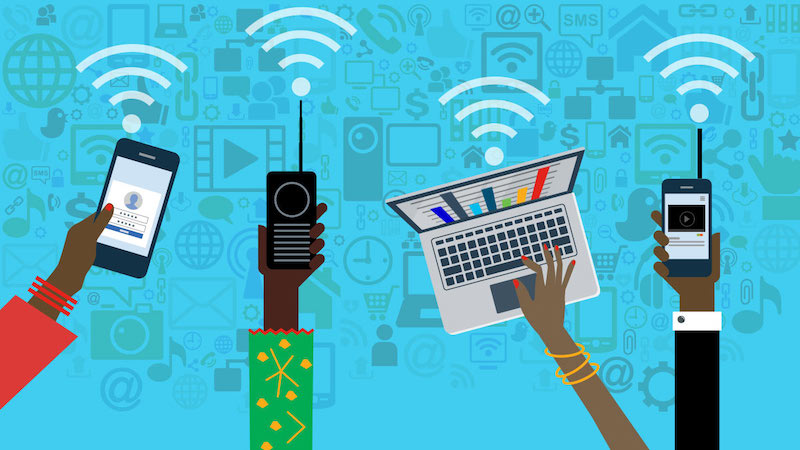After 2020, a whole year of remote work and movement restrictions, the Internet has become a fundamental sales and business promotion tool. Currently, even small brands are migrating online, and the presence of a website and a social media account has ever since become a must for companies development. Products and services sales no longer depend on the availability of offline offices and expensive ad campaigns on TV or in printed magazines like they used to. Anyone who wants to promote their business on the Internet and has a minimum budget can get the right number of customers with the help of online marketing at the lowest cost per conversion. You often manage to get your first clients completely for free, thanks to the variety of traffic sources and a creative approach. In this article, we will talk about the most interesting and useful facts about the Internet and online marketing.
Number of the Internet Users Globally
According to the Digital 2021 study, the number of Internet users around the world is 4.66 billion people. This is 59.5% of the total population of the Earth. Mobile phones are used by 66.6% of the world’s population. And 53.6% have at least one social media account. On average, each year an additional 7% of the planet’s population becomes Internet users. And social networks have seen their audiences grow by 13%.
Slightly less than half of the Earth does not yet have access to the World Wide Web, meaning in the near future it will be possible to create services and products for them that are already available in more developed countries. By analyzing social media users statistics we can state that they continue to serve as the main promotional tool that covers the largest percentage of users. And the number of new users from mobile devices outstrips the number of new users from PCs.
Geography and User Behavior
Due to the impressive population size and advanced technologies, Asia holds 1st place in terms of the number of users — 54.9% of the planet’s population. New up (in terms of numbers) is Europe — 14.3%, Africa — 11.5%, Latin America and the Caribbean — 9.6%, North America — 6.7 %, the Middle East — 3.9 %, Australia and Oceania — 0.6% of the total population. The largest increase in users for 2000-2021 was recorded in Asia, the Middle East, and Latin America. There’s been an explosion of new users in African countries too.
As for the amount of time spent online, the Philippines, Colombia, Brazil and Kenya are in the lead. Most of the time spent is taken up by social media.
The main reason why people go online is still to look for information (63%), connect with relatives and friends (56.3%) as well as obtain updates about news and current events (55.6%).
This information suggests that the largest increase in new users will be in developing countries, and the main sources of traffic are social networks, search engines, news resources and the media.
Points of Interest and User Concerns
Google firmly holds the title of the most popular search engine. Facebook is the most popular social network, followed by Youtube and WhatsApp. By the way, 90% of users aged 16–64 watch YouTube.
Voice technologies are gaining popularity, 43% of all online residents use them. And since the Internet is developing faster than certain countries, this technology can be particularly useful in places where people can’t read and write. Not to mention that voice technologies help break down the language barrier when it comes to translations.
The video game industry is seeing revenue growth of an average of 10% per year. Moreover, the gaming community is no longer made up of exclusive young people — older generations are also part of it now: around 66% of all people aged 55–64 play videogames on this or that device.
Online shopping is becoming increasingly popular, with quarantine being the main driving force behind the growth of е-commerce in 2020. 76.8% of users make online purchases at least once a year. The top online shoppers are residents of Indonesia, the United Kingdom, Thailand, Malaysia, and Poland. Users spent the most on fashion and beauty products, traveling and tourism goods, and electronics and gadgets.
Despite the general convenience and speed of distribution, along with the positive moments, new challenges appear that need to be solved together. The list of popular issues online users are concerned with includes:
- growing disquiet about the unauthorized use of personal data. According to the Global Web Index, 64% of users are concerned about this issue;
- growing annoyance with excessive ads — over 50% of users had ad blockers installed in 2020;
- distrust towards online information and facts — increased to 56% in 2020 and continues to grow by 2–3% each year;
- cybercrime and online fraud rising. Studies claim that global cybersecurity costs will grow 15% per year, with cybercrime revenues in 2021 averaging at $190,000 per second. The most dangerous of all malicious software are ransomware — malware that inflicts maximum damage to the economy and individual businesses.
Online Business
In 2018, 6 out of 10 small businesses lacked a website, and by 2040, according to Nasdaq’s prediction, 95% of all transactions and purchases will be done online. Nevertheless, the two main reasons why people transfer purchases from online to offline are still: the desire to hold a product in their hands and the delivery time being too long.
This tells us that e-commerce will take the majority of sales and move them all online, while technologies that allow to overcome the gap between buyers and the goods presented online will be highly sought after in the coming years.
Here are a few more facts to help you understand online shopper behavior:
- on average, men spend $70 more on online transactions than women;
- 23% of buyers will refuse the purchase if the website requires them to log in to make it;
- the main reasons why people prefer online shopping: favorable prices, loyalty to a specific website or brand, fast delivery and the availability of goods in stock;
- 30% of buyers prefer to return to the site where they once made a purchase;
- 71% of customers believe that online purchases are more profitable than offline shopping;
- attracting a new client is about 5 times more expensive than retaining an existing one.
Based on these facts, we can conclude that the e-commerce market is still far from being able to satisfy even the existing demand, not to mention that the number of users is increasing every year. There are also certain problems when it comes to customer care, presenting the product, and logistics — all these gaps need to be bridged for online shopping to be a more comfortable experience, which in turn will ramp up the conversion rate.
Online Marketing and Sales
With the help of Internet marketing, you can promote not only online companies, but also any sort of offline business.
The most popular platforms to display ads on are Google Ads, YouTube Facebook, and Instagram. Tik-Tok is also gaining significant ground.
Potential customers find video content the most attractive. 40% more users will choose to watch a product video over reading a text description. And by adding video content, you can attract 157% more organic traffic.
Having a blog is becoming a must for any business that wants to grow. For example, small enterprises that have their own blog get 126% more potential clients than their blogless competitors. And 61% of people will make a purchase after seeing a recommendation in a blog, while 94% of people share the content they see on blogs, thinking that it might be of use to their close ones.
Online Business Future Trends
The conditions in which the world found itself in 2020 (namely the quarantine) paved the way for irreversible changes. The main online business development trends will dictate new rules that society will have to abide by. The general development vectors are:
- eliminating the human factor in many areas, moving to AI technologies, machine learning, neural networks and blockchains;
- reducing the barriers between people thanks to technologies that allow the latter to work remotely and adhere to a flexible schedule — meaning greater freedom of movement with the opening of borders;
- transition to new, more advanced data collection technologies, for example, Google is going to completely abandon сollecting data from Cookies by 2023;
- the increasing role and popularity of online education;
- the emergence of new unique technologies that the world has never used before, for example, autopilots, distance medicine, replacement of routine professions with algorithms, digital currencies, and so on.
This article was written in partnership with Galaksion.










Leave a Reply